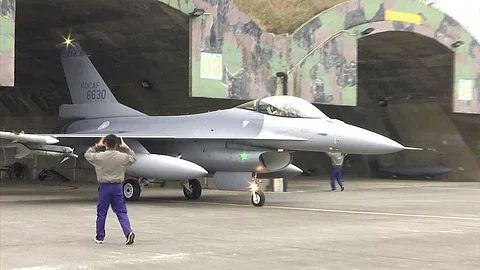

TAIPEI: Taiwan's air force said it had launched a rescue operation to locate one of its most advanced F-16s after the fighter jet vanished from radar screens on Tuesday.
The jet disappeared around half an hour after taking off for a routine training flight from a base in the southern city of Chiayi, the air force said in a statement.
Taiwan's national rescue centre reported that people saw the F-16V "crashing into the sea," adding that two choppers and one coastguard vessel had been dispatched to find the jet.
President Tsai Ing-wen has ordered an all-out rescue effort and asked for clarity around the cause of the incident, her office said.
Taipei commissioned its first squadron of US-made F-16V fighters in November in an effort to upgrade its ageing fleet as tensions with China continue to heighten. Beijing claims the self-ruled island as part of its territory and has vowed to take it one day, by force if necessary.
The F-16V is an upgraded and much more sophisticated version of the island's other F-16 fighters which date back to the 1990s.
The air force has suffered a string of fatal accidents in recent years as its jets are kept under growing pressure from China.
Taiwan also has French-made Mirage jets and its own indigenous warplanes.
Taiwan's parliament on Tuesday passed an extra spending bill of nearly $8.6 billion in its latest bid to boost defence capabilities against an increasingly bellicose China.
The government proposed a five-year special defence budget of around TW$237.3 billion from 2022 as Chinese warplanes breached its air defence zone at unprecedented levels last year.
Democratic Taiwan lives under constant threat of an invasion by authoritarian China, which claims the self-ruled island as part of its territory to be seized one day -- by force if necessary.
Beijing's sabre-rattling towards the island has increased considerably since President Tsai Ing-wen came to power in 2016, as she regards the island as a sovereign nation and not part of "one China."
Last year, Taiwan recorded incursions by around 970 Chinese warplanes into its air defence zone, according to a database compiled by AFP, more than double the roughly 380 carried out in 2020.
On Tuesday, Taiwanese lawmakers agreed unanimously to pass the special budget, although cut it by TW$310 million. The package comes on top of a record annual defence budget of TW$471.7 billion set for 2022.
It aims to acquire various precision missiles and mass-manufacture high-efficiency naval ships "in the shortest period of time" to boost the island's sea and air capabilities, the government said.
J Michael Cole, a Taipei-based political and military analyst, called the special budget "an encouraging and much-needed development" as Taiwan prioritises "asymmetrical" capabilities, such as unmanned vehicles, anti-ship missiles and air-to-ground cruise missiles.
"Many of those are 'counterforce' capabilities, with ranges that are long enough to hit targets along China’s coastline" in line with the direction Taiwan's defence ministry has taken in recent years, said Cole, a senior fellow for Canadian think tank Macdonald-Laurier Institute.
"This move will also be welcomed by the United States, which often complains that Taiwan focuses too much on large conventional platforms at the detriment of smaller, more dispersible and less costly 'asymmetrical' capabilities."
Washington has remained a leading ally and arms supplier to Taipei despite switching diplomatic recognition to Beijing in 1979.
The budget includes a coastal anti-ship missiles system, a locally-developed Wan Chien (Ten Thousand Swords) cruise missile as well as an attack drone system and installation of combat systems on coastguard ships.
Cole also points out the benefit of ensuring quicker delivery as many of the armaments are produced domestically.
"The latter is a crucial part, as Taiwan needs to make sure it has the capabilities to deter, and if needed to counter, a Chinese attack now, not five, ten years from now."
China has publicised multiple recent military drills simulating an invasion of the island.
For decades, analysts largely concurred that invading Taiwan is a challenge China could not pull it off but Beijing has dramatically closed the gap in recent years.